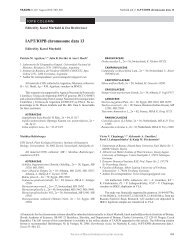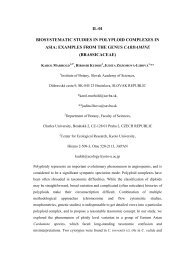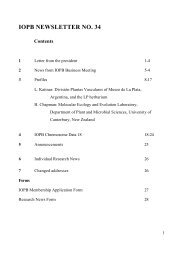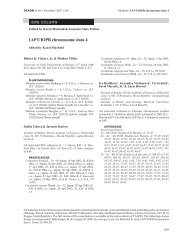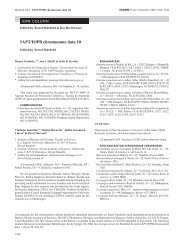CONTENS - International Organization of Plant Biosystematists
CONTENS - International Organization of Plant Biosystematists
CONTENS - International Organization of Plant Biosystematists
Create successful ePaper yourself
Turn your PDF publications into a flip-book with our unique Google optimized e-Paper software.
O 03<br />
Phylogeographical structure <strong>of</strong> alpine plants in the Carpathians: a<br />
comparative study<br />
Michał Ronikier 1 & Intrabiodiv Consortium 2<br />
1 Institute <strong>of</strong> Botany, Polish Academy <strong>of</strong> Sciences, Lubicz 46, PL-31-512 Kraków,<br />
Poland; e-mail: michal.ronikier@ib-pan.krakow.pl; 2 www.intrabiodiv.eu<br />
The Carpathians belong to major mountain ranges forming the European alpine<br />
system and form a mountain arch extending over ca 400 km. With a comparable<br />
spatial extension but deviating in topography and glacial history, the Carpathians<br />
provide a different system than the European Alps for studying the Quaternary history<br />
<strong>of</strong> alpine plants. Alpine areas form here a discontinuous island system, separated by<br />
large forested and subalpine areas. Unlike the Alps, the Carpathians were not<br />
extensively glaciated during the Quaternary; glaciers developed only locally, while<br />
lower massifs remained ice-free. Only the highest Carpathian ridges, like the Tatra<br />
mountains (the highest massif, 2663 m a.s.l.), showed more extended glaciation. In<br />
contrast, while plant habitats in the Alps were mostly limited to marginal refugia,<br />
alpine areas were extended in the large ice-free and treeless Carpathian ranges,<br />
potentially enabling range extensions for high-mountain plants. In the present study,<br />
populations <strong>of</strong> 14 high-mountain species distributed in alpine habitats across the<br />
Carpathians were studied using AFLP markers to infer their genetic structure.<br />
Additionally, chloroplast DNA sequences were examined in part <strong>of</strong> species to test the<br />
phylogeographical groups detected. Most species were characterized by a significant<br />
phylogeographical structure in the Carpathians and several well-supported regional<br />
groups were detected. A main genetic break supported by results from most taxa<br />
separated Western and South-Eastern Carpathians, following the well-known<br />
phytogeographical boundary. Further genetic groups were found in the SE<br />
Carpathians, suggesting for several species a last glacial isolation in several regional<br />
refugia rather than population expansion potentially favoured by extension <strong>of</strong> ice-free<br />
and treeless areas.<br />
4



